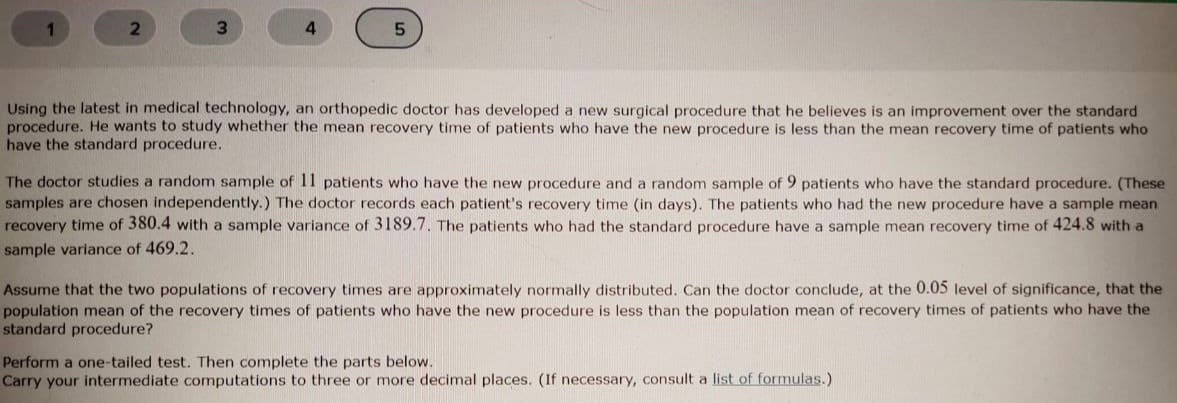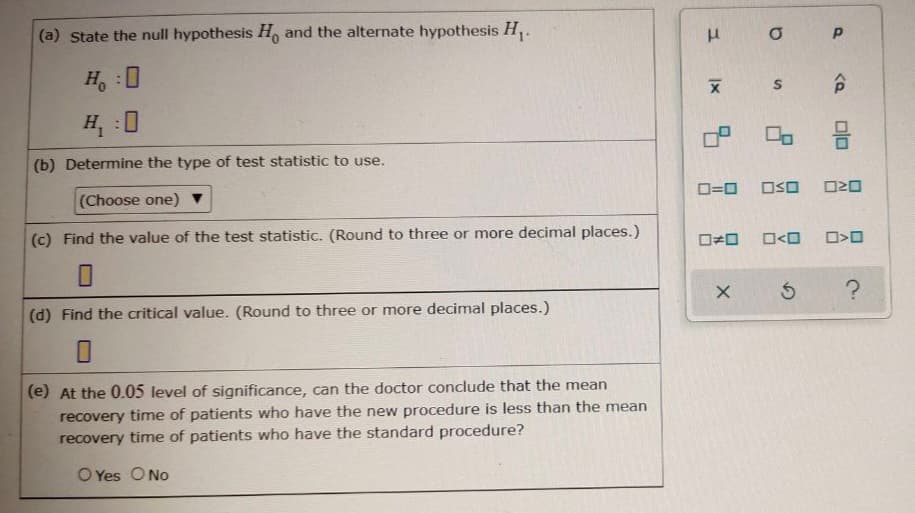Using the latest in medical technology, an orthopedic doctor has developed a new surgical procedure that he believes is an improvement over the standard procedure. He wants to study whether the mean recovery time of patients who have the new procedure is less than the mean recovery time of patients who have the standard procedure. The doctor studies a random sample of 11 patients who have the new procedure and a random sample of 9 patients who have the standard procedure. (These samples are chosen independently.) The doctor records each patient's recovery time (in days). The patients who had the new procedure have a sample mean recovery time of 380.4 with a sample variance of 3189.7. The patients who had the standard procedure have a sample mean recovery time of 424.8 with a sample variance of 469.2. Assume that the two populations of recovery times are approximately normally distributed. Can the doctor conclude, at the 0.05 level of significance, that the population mean of the recovery times of patients who have the new procedure is less than the population mean of recovery times of patients who have the standard procedure? Perform a one-tailed test. Then complete the parts below. Carry your intermediate computations to three or more decimal places. (If necessary, consult a list of formulas.)
Using the latest in medical technology, an orthopedic doctor has developed a new surgical procedure that he believes is an improvement over the standard procedure. He wants to study whether the mean recovery time of patients who have the new procedure is less than the mean recovery time of patients who have the standard procedure. The doctor studies a random sample of 11 patients who have the new procedure and a random sample of 9 patients who have the standard procedure. (These samples are chosen independently.) The doctor records each patient's recovery time (in days). The patients who had the new procedure have a sample mean recovery time of 380.4 with a sample variance of 3189.7. The patients who had the standard procedure have a sample mean recovery time of 424.8 with a sample variance of 469.2. Assume that the two populations of recovery times are approximately normally distributed. Can the doctor conclude, at the 0.05 level of significance, that the population mean of the recovery times of patients who have the new procedure is less than the population mean of recovery times of patients who have the standard procedure? Perform a one-tailed test. Then complete the parts below. Carry your intermediate computations to three or more decimal places. (If necessary, consult a list of formulas.)
Glencoe Algebra 1, Student Edition, 9780079039897, 0079039898, 2018
18th Edition
ISBN:9780079039897
Author:Carter
Publisher:Carter
Chapter10: Statistics
Section10.4: Distributions Of Data
Problem 19PFA
Related questions
Question
Answer letter d and e pls. I don't want to waste my money here.

Transcribed Image Text:1.
4.
Using the latest in medical technology, an orthopedic doctor has developed a new surgical procedure that he believes is an improvement over the standard
procedure. He wants to study whether the mean recovery time of patients who have the new procedure is less than the mean recovery time of patients who
have the standard procedure.
The doctor studies a random sample of 11 patients who have the new procedure and a random sample of 9 patients who have the standard procedure. (These
samples are chosen independently.) The doctor records each patient's recovery time (in days). The patients who had the new procedure have a sample mean
recovery time of 380.4 with a sample variance of 3189.7. The patients who had the standard procedure have a sample mean recovery time of 424.8 with a
sample variance of 469.2.
Assume that the two populations of recovery times are approximately normally distributed. Can the doctor conclude, at the 0.05 level of significance, that the
population mean of the recovery times of patients who have the new procedure is less than the population mean of recovery times of patients who have the
standard procedure?
Perform a one-tailed test. Then complete the parts below.
Carry your intermediate computations to three or more decimal places. (If necessary, consult a list of formulas.)

Transcribed Image Text:(a) State the null hypothesis H, and the alternate hypothesis H,.
H, :0
合
H :0
(b) Determine the type of test statistic to use.
(Choose one) ▼
D=0
OSO
O20
(c) Find the value of the test statistic. (Round to three or more decimal places.)
O<O
(d) Find the critical value. (Round to three or more decimal places.)
(e) At the 0.05 level of significance, can the doctor conclude that the mean
recovery time of patients who have the new procedure is less than the mean
recovery time of patients who have the standard procedure?
O Yes O No
Expert Solution
This question has been solved!
Explore an expertly crafted, step-by-step solution for a thorough understanding of key concepts.
This is a popular solution!
Trending now
This is a popular solution!
Step by step
Solved in 4 steps with 1 images

Recommended textbooks for you

Glencoe Algebra 1, Student Edition, 9780079039897…
Algebra
ISBN:
9780079039897
Author:
Carter
Publisher:
McGraw Hill

Glencoe Algebra 1, Student Edition, 9780079039897…
Algebra
ISBN:
9780079039897
Author:
Carter
Publisher:
McGraw Hill